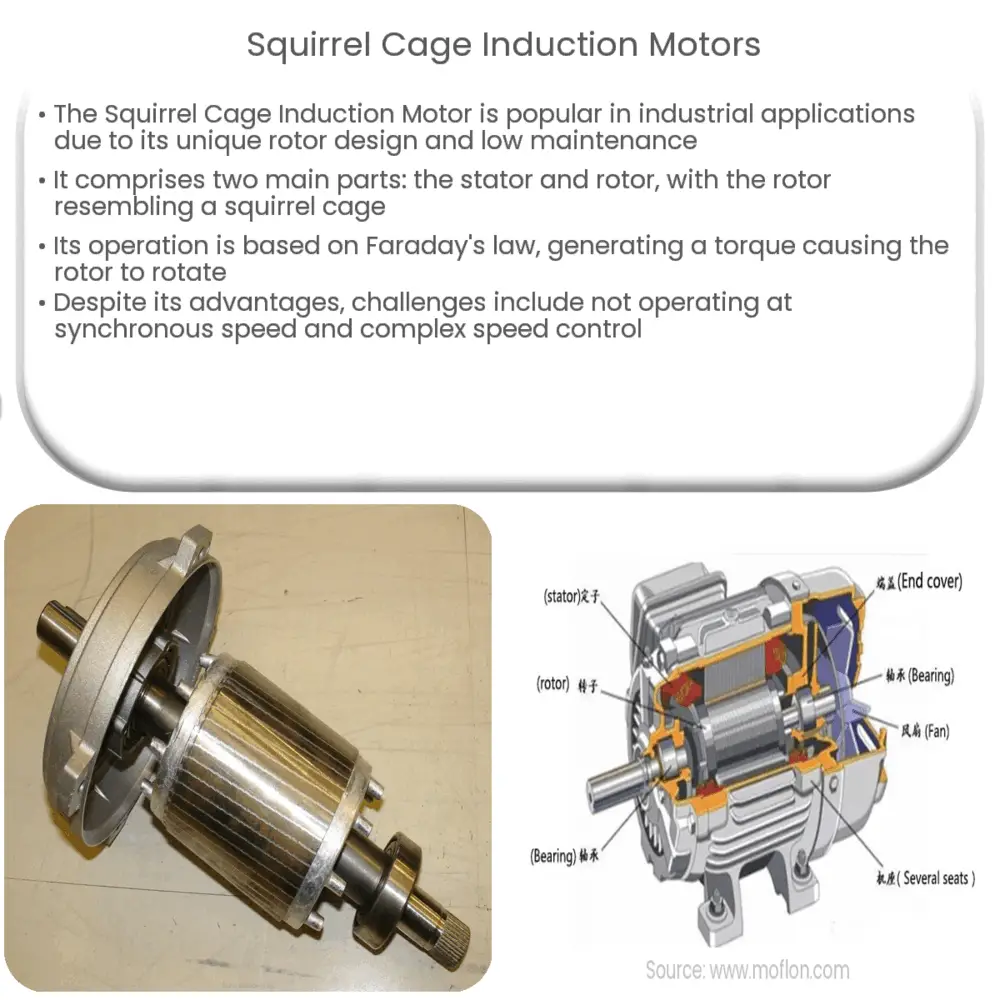Explore the basics, working principles, advantages, applications, and limitations of Squirrel Cage Induction Motors in this comprehensive guide.

Introduction to Squirrel Cage Induction Motors
In the world of electric motors, the Squirrel Cage Induction Motor stands out as one of the most commonly used types, particularly in industrial applications. It’s named “Squirrel Cage” due to the unique construction of its rotor that resembles a squirrel cage. The simplicity of its design, coupled with its high durability and low maintenance requirements, makes it an attractive choice for many.
The Basic Structure
A Squirrel Cage Induction Motor consists of two main parts: the stator and the rotor. The stator is the stationary part of the motor, which contains the motor’s windings. The rotor, which is the rotating part of the motor, is constructed from bars of conductive material, typically aluminum, shorted at each end by conductive end rings, forming a shape reminiscent of a squirrel cage.
- Stator: The stator houses three-phase windings placed 120 degrees apart. When a three-phase supply is given to the motor, a rotating magnetic field is established.
- Rotor: In the Squirrel Cage design, the rotor bars are skewed to reduce magnetic hum and to improve torque. When the rotating magnetic field cuts across the rotor bars, it induces a current, creating a secondary magnetic field. The interaction of these two fields causes the rotor to rotate.
Working Principle
The working principle of the Squirrel Cage Induction Motor is based on Faraday’s law of electromagnetic induction. When a three-phase voltage is applied to the stator windings, it generates a rotating magnetic field. This rotating field induces a current in the rotor bars, creating a magnetic field around each bar. The interaction between the stator’s magnetic field and the rotor’s magnetic field generates a torque that causes the rotor to rotate, hence driving the motor.
Key Advantages
Squirrel Cage Induction Motors offer a number of benefits that contribute to their widespread usage in various industrial applications.
- They are simple in construction and therefore require less maintenance.
- The motors offer high reliability and a robust design, leading to extended service life.
- They provide high efficiency and good power factor, making them economically viable.
- The motors are self-starting, eliminating the need for additional starting mechanisms.
Common Applications
Squirrel Cage Induction Motors find applications in numerous fields due to their inherent advantages.
- Industrial Applications: These motors are widely used in the industrial sector due to their robustness and reliability. They’re used in pumps, compressors, conveyor systems, and manufacturing machinery.
- Electric Vehicles: In recent years, squirrel cage motors have gained traction in electric vehicles for their high efficiency and durability.
- Home Appliances: Smaller squirrel cage motors are also used in various home appliances like washing machines, air conditioners, and refrigerators.
Potential Limitations
Despite their many advantages, Squirrel Cage Induction Motors are not without their drawbacks.
- The motor cannot be operated at a synchronous speed. This is because if the motor runs at a synchronous speed, there would be no relative motion between the stator’s rotating magnetic field and the rotor, thus no induced emf and no rotor current.
- Another limitation is the difficulty in speed control. It requires complex methods like variable frequency drives or pole changing methods.
Conclusion
To sum up, the Squirrel Cage Induction Motor is a mainstay in the realm of electric motors due to its many attributes such as simplicity in design, high reliability, and operational efficiency. Despite its limitations, the Squirrel Cage Induction Motor’s benefits outweigh the disadvantages in many scenarios, making it a practical choice for various applications, from industrial machines to electric vehicles and home appliances.
Understanding its operation, benefits, and limitations is crucial for engineers and technicians working in fields where these motors are commonly employed. Continuous advancements and improvements are being made to overcome the existing drawbacks, ensuring that Squirrel Cage Induction Motors will continue to play a vital role in the future of electromechanical energy conversion.

